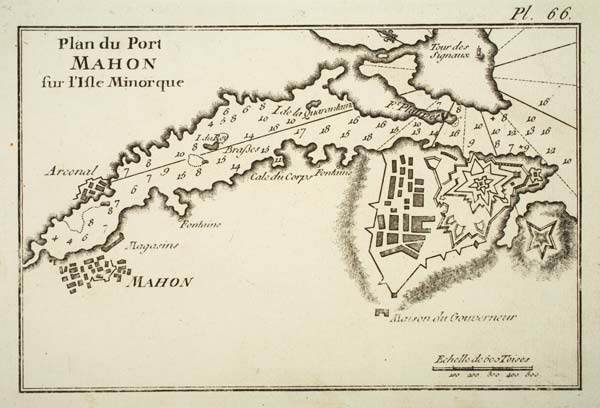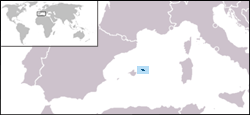Quote:
Originally Posted by Greg

Aaaarggghhh!!
From page 213:
 He's sailing toward the rising sun out of Mahon.
Maps really help in figuring out what's happening in this book!
He's sailing toward the rising sun out of Mahon.
Maps really help in figuring out what's happening in this book!
Fortunately she was moored with simple warps fore and aft, so there would be no slow weighing of anchors, no stamp and go at the capstan, no acid shrieking of the fiddle; in any case, the comparatively sober members of the crew were too jaded for anything but a sour, mute, expeditious casting-off -- no jolly tars, no hearts of oak, no Brittons never, never, in this grey stench of a crapulous dawn. Fortunately, too, he had seen to the repairs, stores and vitualling (apart from that cursed last voyage of water) before he or anyone else had set foot on the shore; and rarely had he appreciated the reward of virtue more than when the Sophie's jib filled and her head came round, pointing easteward to the sea, a wooded, watered, well-found vessel beginning her journey back to indepedence. I understand that Captain Jack Aubrey wanted to get away from the harbor at Mahón quietly, but what in the name of blue blazes is he talking about?
 Minorca
We are here.
Minorca
We are here. |
Quote:
Originally Posted by Miros1

The capstan is the big round horizontal thingie that pulls the anchor up and the sailors usually sing while walking around it pushing on the bars to make it turn, so I assume that's the "stamp and go."
I think I vaguely remember something about the water being the last thing loaded, to try to keep it fresher, so that would be the "last voyage of water."
|
This girls good.

The capstan "head" is the big round thingy, with 4 spokes poking out, that turns the windlass head below deck. This in turn, drives the endless rope that is "nipped" to the anchor cable to raise or weigh anchor. The anchor cable as it is properly called, (whether of rope, steel wire, chain, it is the anchor cable) is not wound around either the capstan or the windlass, but runs alongside the endless rope that is wound between the two big round thingy's.
This, is the origins of the term Nipper for a young lad. When a ship had to set sail, the ships boatswain, (pronounced bos'n), would bring a group of dockside urchins on board to work in the lower forecastle, pronounced Foeks'l, using a small length of rope, flicked over the anchor cable and windlass ropes, with a full round turn, then the ends pulled tight, these boys would nip the 2 ropes together, trot up alongside the setup for a few feet, then un-nip and run back to the beginning of the line, nip and run. Nippers.
The word "nickers" is also from the days of sail and "press-ganging".
If a man had done his "duty" for the King, this was signified by a nick to the ear. Not unlike marking herd animals really. If word got around the "National Service Recruiters" (my terminology) were doing the rounds. Somebody would start "nicking" the ears of people to order. They were the original "nickers", not the unmentional ladies garments we think of today.
Greg, simple warps are just single ropes. Any vessel has only one rope, by name, the Bell rope, all others are lines, halyards, hausers, warps, but they are
made of rope.
Simple warps, 1 forward to a bhouy, we pronounce it "boy", the other out aft to a similar "ground tackle". If he had any sense the warps should have been passed through the "mooring ring eye" on the mooring bhouy, then brought back onboard to be secured to the ships mooring bits. (the ships equivalent to a wharfe bollard) No need to send a boat away to unfasten at the bhouy, for fast, and quiet get away, loose off from the bits, and haul the line back in, whilst getting sail up. Jobs done.
No shreiking of the fiddle? Or squeazebox, good.
Sea shanties were a way to set the work pace, for a real bitch, drudge job like, oh, let's say weighing anchor. You worked to the tempo of the song, stamping the feet in time to the music as you march round and round and round and round and


.
A tar is a sailor, a sailor with a hangover? Not a jolly tar.

Heart of Oak? One of the ships I served on, named HMAS Stalwart, her motto? Heart of Oak. Stout, steadfast and true.
However, in this case, these are old Royal Navy sea shanties. Work songs. The slaves learned drudge singing from the sailors. The songs of the cotton and tobacco slaves began as copied sea shanties, I believe.
With a healthy does of Baptism beaten into the mix of course.
The rest is no more than any yachtsman does.
At sea, "stores" are parts, bits and pieces, stove fuels etc. Victualling is food.
Wooded, watered and well found. No expense spared to make her as safe and sound as any ship of man can be. Hark back to coppered bottoms and "well found ships". And of course, a ship is independant at sea. We are one.
The author seems to like throwing in the pub talk, that was used for the benefit of the lubbers.
It also seems like our man Jack, was a student of dear old Admiral Benbow.
Harbours, rot ships and men, get my ships to sea now.
He also said, give me the boy until he is 7, and I will return to you the man.
To do with instilling virtues into the child, whilst they are more willing to listen and learn. Very astute man, the old Admiral.